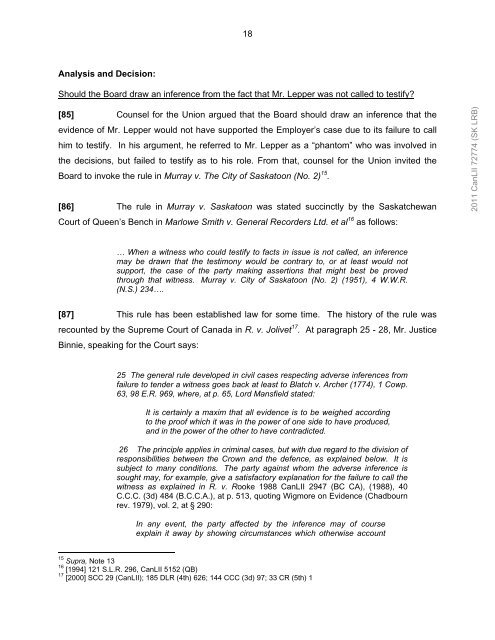FAQ's Cases - Stewart McKelvey
FAQ's Cases - Stewart McKelvey
FAQ's Cases - Stewart McKelvey
- No tags were found...
Create successful ePaper yourself
Turn your PDF publications into a flip-book with our unique Google optimized e-Paper software.
18Analysis and Decision:Should the Board draw an inference from the fact that Mr. Lepper was not called to testify?[85] Counsel for the Union argued that the Board should draw an inference that theevidence of Mr. Lepper would not have supported the Employer’s case due to its failure to callhim to testify. In his argument, he referred to Mr. Lepper as a “phantom” who was involved inthe decisions, but failed to testify as to his role. From that, counsel for the Union invited theBoard to invoke the rule in Murray v. The City of Saskatoon (No. 2) 15 .[86] The rule in Murray v. Saskatoon was stated succinctly by the SaskatchewanCourt of Queen’s Bench in Marlowe Smith v. General Recorders Ltd. et al 16 as follows:2011 CanLII 72774 (SK LRB)… When a witness who could testify to facts in issue is not called, an inferencemay be drawn that the testimony would be contrary to, or at least would notsupport, the case of the party making assertions that might best be provedthrough that witness. Murray v. City of Saskatoon (No. 2) (1951), 4 W.W.R.(N.S.) 234….[87] This rule has been established law for some time. The history of the rule wasrecounted by the Supreme Court of Canada in R. v. Jolivet 17 . At paragraph 25 - 28, Mr. JusticeBinnie, speaking for the Court says:25 The general rule developed in civil cases respecting adverse inferences fromfailure to tender a witness goes back at least to Blatch v. Archer (1774), 1 Cowp.63, 98 E.R. 969, where, at p. 65, Lord Mansfield stated:It is certainly a maxim that all evidence is to be weighed accordingto the proof which it was in the power of one side to have produced,and in the power of the other to have contradicted.26 The principle applies in criminal cases, but with due regard to the division ofresponsibilities between the Crown and the defence, as explained below. It issubject to many conditions. The party against whom the adverse inference issought may, for example, give a satisfactory explanation for the failure to call thewitness as explained in R. v. Rooke 1988 CanLII 2947 (BC CA), (1988), 40C.C.C. (3d) 484 (B.C.C.A.), at p. 513, quoting Wigmore on Evidence (Chadbournrev. 1979), vol. 2, at § 290:In any event, the party affected by the inference may of courseexplain it away by showing circumstances which otherwise account15 Supra, Note 1316 [1994] 121 S.L.R. 296, CanLII 5152 (QB)17 [2000] SCC 29 (CanLII); 185 DLR (4th) 626; 144 CCC (3d) 97; 33 CR (5th) 1
















